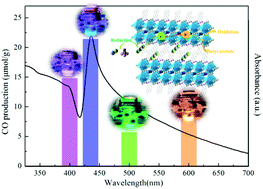Monochromatic light-enhanced photocatalytic CO2 reduction based on exciton properties of two-dimensional lead halide perovskites†
Abstract
Converting CO2 into valuable solar fuels through photocatalysis has been considered a green and sustainable technology that is promising for alleviating global warming and providing energy in an environmentally friendly manner. However, traditional photocatalysts generally suffer from low surface-reactive reaction sites, inefficient light harvesting and rapid recombination of electron–hole pairs. Lead halide perovskite materials have been considered ideal semiconductor photocatalysts for photocatalytic CO2 reduction due to their tunable band gaps, strong light absorption, and low cost. Herein, a series of L2Csn−1PbnX3n+1 (L = ba, ha, oa; X = Cl, Br, I; n = 1, 2) 2D layered perovskites were synthesized by a facile solvothermal method. The effects of alkyl amine chain length, halogen atoms and inorganic layer number on their properties were studied. More importantly, these 2D materials were used as photocatalysts for CO2 reduction without any sacrificial agents. These 2D perovskites exhibited markedly increased performance in comparison with 3D bulk materials, benefitting from the larger surface-area-to-volume ratio and faster and more efficient exciton dissociation, which achieved the highest CO yield of 158.69 μmol g−1 h−1 and CH4 yield of 6.9 μmol g−1 h−1 through the design of the photocatalytic system. In addition, the influence of light source conditions on photocatalysis was studied systematically, including light source intensity and wavelength. The experimental results indicated that an appropriate solvent, high light intensity and monochromatic light source matching the wavelength of exciton absorption can effectively improve the photocatalytic efficiency.



 Please wait while we load your content...
Please wait while we load your content...